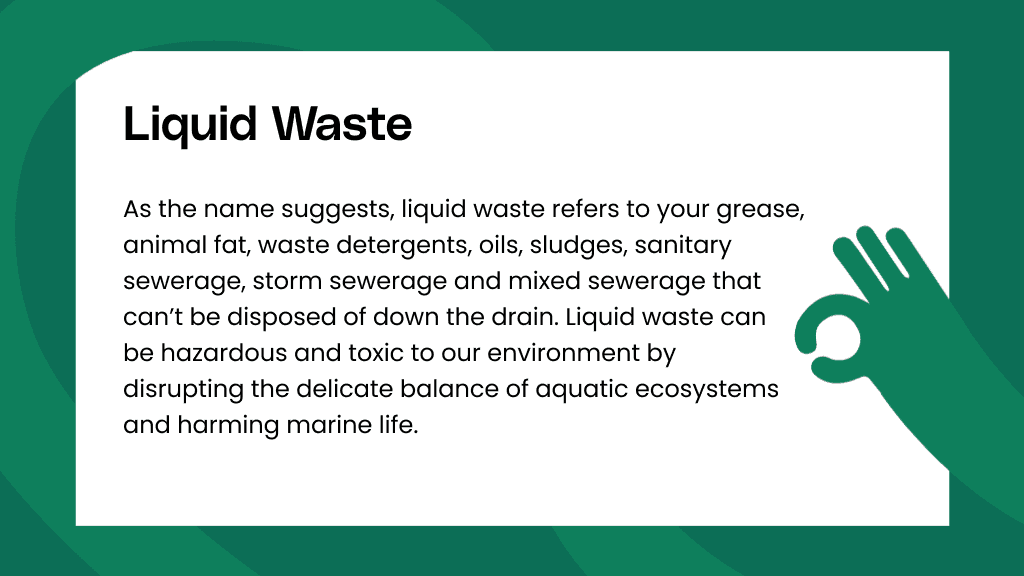The 10-Minute Rule for Reclaim Waste
The 10-Minute Rule for Reclaim Waste
Blog Article
Everything about Reclaim Waste
Table of ContentsReclaim Waste Things To Know Before You Buy4 Easy Facts About Reclaim Waste ExplainedWhat Does Reclaim Waste Do?Reclaim Waste for DummiesThe Main Principles Of Reclaim Waste
Check out the kinds, occurrences, and kinds of liquid waste. Domestic sewer waste refers to the waste and products from a property septic system. This kind of waste is developed by people in residences, colleges, and other buildings. This only consists of septic systems that have a drain area. The proper management and disposal of domestic sewer waste call for fluid waste to be transferred to a sewage treatment plant where the appropriate approaches and devices are put on purify and take care of waste.
Commercial waste usually consists of potential dangers, such as combustible products or a mixture of liquid and strong waste products, and calls for a more sophisticated and in-depth disposal process. The disposal of commercial waste normally includes the purification of waste before transport to make sure secure and appropriate disposal. Hazardous waste is developed from results and overflow of commercial processes and production.
This kind of waste can not make use of the same sewage administration transport or procedures as septic or commercial fluids. The hazardous waste monitoring process calls for the inspection and testing of liquid waste prior to it undertakes the disposal procedure (liquid waste disposal melbourne). Overflow waste is the fluid waste that originates from runoff and excess stormwater in extremely populated locations or cities
Runoff waste can trigger contamination and flooding if not managed properly. Find out more concerning sewer cleansing and waste monitoring. Making sure correct waste monitoring can protect against catastrophes and minimize environmental harm. Both individuals in domestic settings and experts in business or production industries can gain from comprehending the processes and regulations of liquid waste administration.
Reclaim Waste Can Be Fun For Anyone
Contact PROS Solutions today to learn more about our waste management and disposal solutions and the correct methods to take care of the fluid waste you create.
(https://linktr.ee/leonaube33101)Do you know what occurs to your water when you draw the plug, purge the toilet or drain pipes the cleaning device? No? Well, it's worth understanding. This supposed 'wastewater' is not only an essential resource but, after therapy, will certainly be released to our land, rivers or the sea. Utilized water from toilets, showers, bathrooms, kitchen area sinks, laundries and commercial processes is known as wastewater.

water utilized to cool down equipment or clean plant and tools). Stormwater, a kind of wastewater, is drainage that flows from farming and urban areas such as roofs, parks, yards, roadways, paths and rain gutters into stormwater drains pipes, after rainfall. Stormwater flows untreated straight to neighborhood creeks or rivers, at some point getting to the sea.
Not known Factual Statements About Reclaim Waste
In Queensland, many wastewater is dealt with at sewage therapy plants. Wastewater is moved from domestic or industrial websites with a system of sewage systems and pump stations, referred to as sewerage reticulation, to a sewage treatment plant. City governments develop, keep and run most sewer treatment plants. Operators are accredited under the Environmental Management Act 1994 to discharge treated wastewater at an appropriate ecological criterion into rivers.
The Division of Natural Resources advises local federal governments about handling, operating and keeping sewage systems and therapy plants. In unsewered locations, local governments might need householders to mount specific or home sewer therapy systems to deal with domestic wastewater from toilets, kitchens, shower rooms and laundries. The Department of Natural Resources authorises the usage of home systems when they are shown to be efficient.
In some brand-new class, therapy of some stormwater to get rid of litter, sand and crushed rock has actually started using gross pollutant catches. Wastewater treatment happens in 4 stages: Gets rid of strong matter.
Wastewater then moves right into huge containers where solids work out and are have a peek at this site gotten rid of as sludge. Grease and residue are skimmed from the surface area. Uses small living microorganisms called micro-organisms to break down and get rid of staying liquified wastes and great fragments. Micro-organisms and wastes are incorporated in the sludge. Gets rid of nitrogen and phosphorus nutrients that could trigger algal flowers in our rivers and intimidate marine life.
The Buzz on Reclaim Waste
Nutrient removal is not readily available at all sewer therapy plants since it needs costly specialist tools. It is becoming much more common in Queensland. Clear fluid effluent produced after treatment may still include disease-causing micro-organisms. If this effluent is released into rivers such as rivers or the sea, the micro-organisms will eventually die out.

Many wastewater flows right into the sewerage system. Under the Act, neighborhood federal governments carry out approvals and permits for ecologically relevant tasks (ERAs) entailing wastewater launches that may have a local effect.
Not known Details About Reclaim Waste
Or else, examples are taken for research laboratory analysis. Usually numerous examinations are needed to establish the levels of each of the various pollutants such as oils, heavy steels and chemicals in water. Monitoring supplies valid details about water top quality and can confirm that licence conditions are being satisfied. The details obtained through monitoring gives the basis for making water quality decisions.
Report this page